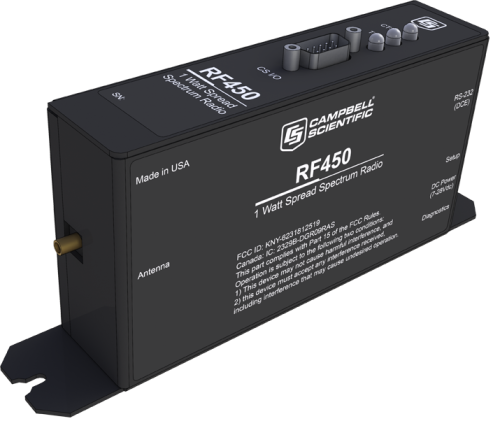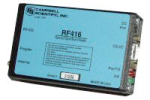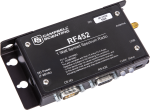This product is not available for new orders. We recommend ordering: RF452.

| Services Available | |
|---|---|
| Repair | Yes |
| Calibration | No |
| Free Support | Yes |
Overview
The RF450 is a frequency-hopping, spread-spectrum radio that operates within the 902 to 928 MHz license-free band. This 1 W radio provides a solution for wireless network communications over longer distances (13 to 60 miles, depending on antenna and line-of sight). Designed specifically for our PakBus® dataloggers, the RF450 works particularly well in point-to-multipoint PakBus networks.
Read MoreBenefits and Features
- Individual FCC license not required
- Maximum transmission distance of 60 miles, and realistic reliable transmission distance of approximately 13 miles
- Low current drain
- Wide operating temperature range
- High data transfer speeds
- High noise immunity—superior performance in noise congested environments
- Error Free Communications—32 bit Cyclical Redundancy Checking (CRC) with automatic retransmission
- Ability to have stand-alone RF router/repeaters (up to 8 repeaters)
- Real time remote diagnostics and setup, transparent to network communications
Images








CAD Files:
Detailed Description
The RF450 consists of a radio module manufactured by FreeWave Technologies and a Campbell Scientific interface board. It reduces susceptibility to RF interference from other spread spectrum devices by providing user-selectable frequency hopping patterns.
Spread spectrum radios spread the normally narrowband information signal over a relatively wide band of frequencies. This process allows communications to be more immune to noise and interference from RF sources such as pagers and cellular phones.
Compatibility
Note: The following shows notable compatibility information. It is not a comprehensive list of all compatible or incompatible products.
Dataloggers
| Product | Compatible | Note |
|---|---|---|
| CR1000 (retired) | ||
| CR200X (retired) | The internal radio of the CR200X-series dataloggers should not be used with the RF450. | |
| CR206X (retired) | The internal radio of the CR200X-series dataloggers should not be used with the RF450. | |
| CR211X (retired) | The internal radio of the CR200X-series dataloggers should not be used with the RF450. | |
| CR216X (retired) | The internal radio of the CR200X-series dataloggers should not be used with the RF450. | |
| CR295X (retired) | The internal radio of the CR200X-series dataloggers should not be used with the RF450. | |
| CR3000 (retired) | ||
| CR5000 (retired) | The RF450 does not support a connection with more than one CR5000 or CR9000X datalogger, because the host RF450 radio does not support slave switchable addressing and our CR5000 and CR9000X dataloggers do not have PakBus routing protocol. | |
| CR6 | ||
| CR800 (retired) | ||
| CR850 (retired) | ||
| CR9000X (retired) | The RF450 does not support a connection with more than one CR5000 or CR9000X datalogger, because the host RF450 radio does not support slave switchable addressing and our CR5000 and CR9000X dataloggers do not have PakBus routing protocol. Although the CR9000X is compatible, the RF450 does not support its fastest communication rates, and therefore may not be practical for many CR9000X applications. |
Additional Compatibility Information
Other Spread-Spectrum Radios
The RF450 can be used in networks containing FGR-115 radios. Campbell Scientific does not recommend using the RF450 with our RF401-series radios or RF430-series radios.
Enclosure Considerations
A desiccated, non-condensing environment is required. The RF450 includes built-in keyhole flanges for mounting to the backplate of a Campbell Scientific enclosure.
Specifications
| Operating Frequency | 902 to 928 MHz |
| Radio Type | Frequency Hopping Spread Spectrum (FHSS) Transceiver |
| FCC ID | KNY-6231812519 |
| Canada ID | 2329B-DGR09RAS |
| Power Output | 5 mW to 1 W (user selectable) |
| Transmit Range | Maximum transmission distance of 60 miles, and realistic reliable transmission distance of ~13 miles. (All transmission distances assume line-of-sight and appropriate antenna; line-of-sight obstructions, RF interference, and antenna type affect transmission distance.) |
| Modulation | 120 or 170 kbps (GFSK) |
| Occupied Bandwidth | 230 kHz (at 60 dB) |
| Channel Spacing | 230 kHz |
| Hopping Patterns | 15 per band, 105 total (user selectable) |
| Hopping Channels | 50 to 112 (user selectable) |
| Hopping Bands | 7 (user selectable) |
| Frequency Zones | 16 (7 channels per zone) |
| Receiver Sensitivity |
|
| Receiver Selectivity |
|
| System Gain | 140 dB |
| Error Detection | 32-bit CRC (retransmit on error) |
| Data Encryption | Substitution, dynamic key |
| Link Throughput | 115.2 kbps (maximum) |
| Data Interface Protocol | CS I/O, RS-232, DCE, ME and SDC (user selectable) |
| RS-232 Baud Rate | 1200, 4800, 9600, 19.2k, 34.4k, 57.6k, or 115.2k bps (user selectable) |
| RS-232 Connector | 9-pin D socket (female) (4 wire: Tx, Rx, CTS, GND) |
| CS I/O Connector | 9-pin D pin (male) (Newer data loggers provide power to the radio on the CS I/O connector; data loggers purchased before December 1997 require the #14291 Field Power Cable.) |
| Antenna Connector | Type SMA socket (female) |
| Power Connector | Barrel plug, center positive 12 V (used to connect the 14291 Field Power Cable or 15966 AC adapter) |
| Input Voltage | 7 to 28 Vdc |
| Operating Temperature Range | -40° to +75°C |
| Relative Humidity | 0 to 95% RH (non-condensing) |
| Dimensions |
|
| Weight | 0.3 kg (0.7 lb) |
Average Current Drain @ 12 Vdc |
|
| Sleep | 7 mA |
| Idle | 22 mA |
| Receiving | 76 mA |
| Transmitting | 500 mA |
Documents
Brochures
Manuals
Downloads
RF450 OS v.02 (415 KB) 31-07-2013
Current RF450 firmware. The Device Configuration Utility is used to update the firmware in the RF450.
Device Configuration Utility v.2.33 (49.6 MB) 07-07-2025
A software utility used to download operating systems and set up Campbell Scientific hardware. Also will update PakBus Graph and the Network Planner if they have been installed previously by another Campbell Scientific software package.
Supported Operating Systems:
Windows 11 or 10 (Both 32 and 64 bit)
Frequently Asked Questions
Number of FAQs related to RF450: 6
Expand AllCollapse All
-
Any RS-232 transmission will work with the RF450.
-
No. They do not use the same over-the-air communications protocol. In fact, unless extra steps are taken, the two models will cause interference with each other.
-
There are many cavity- and notch-type filters available from third-party manufacturers.
-
Antenna selection depends on multiple criteria:
- Consider how many stations a particular station needs to communicate with. For remote stations in communication with only one repeater or base station, a directional or Yagi antenna may be an appropriate choice. In contrast, repeater stations that receive data from many different locations will probably require an omnidirectional antenna.
- Consider if a high-gain antenna is needed to overcome the path between two points. Higher-gain antennas are larger and more expensive.
To help with antenna selection and site placement, consider renting and using a demo kit to test the pathway quality. Campbell Scientific offers a 900 MHz demo kit for the RF401, RF430, CR206X, and AVW206, as well as a demo kit for the RF450. Contact Campbell Scientific for assistance.
-
Yes. This type of connection is called a PakBus network. The intermediate CR1000 needs to be enabled as a router, and a suitable telemetry link needs to exist between the two CR1000 dataloggers.
Case Studies
The Yuba County Water Agency (YCWA) needed to upgrade an unsupportable hydrologic supervisory, control, and......read more
In 2013, RESPEC and the Dewhurst Group began collaborating on the Nevado del Ruiz geothermal......read more
The Hubbard Brook Experimental Forest (HBEF), located in the White Mountain National Forest of central......read more
The semiarid region just north of the Black Hills in western South Dakota has vast......read more
The Bridge Engineering Section of the Oregon Department of Transportation (ODOT) developed a structural health......read more
In 2010, Trenton and Amalga, two northern Utah towns separated by only a few miles,......read more
High-grade coal has been mined on the West Coast of New Zealand since the 1870s.......read more
In the past, home and business owners along the creek that comes from Mantua Reservoir,......read more











